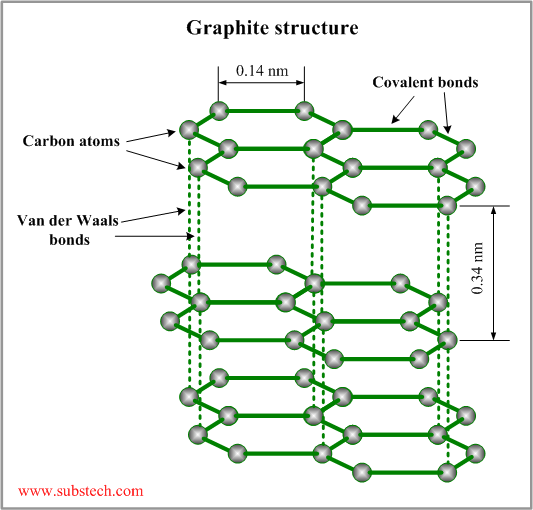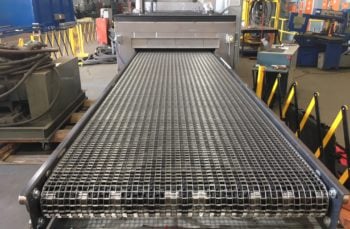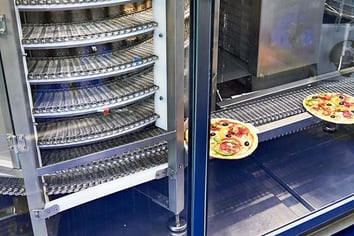
Catch Metcar in the October 2022 issue of Pumps & Systems to learn about how carbon graphite can be a solution in food and beverage processing.
Carbon graphite is employed by businesses to decrease costs, improve efficiency and ensure public safety across the food processing industry. Carbon graphite’s mechanical/chemical properties and its sanitary attributes make it a material to consider when designing conveyor ovens, blanchers and sterilization equipment, to name a few. This article will highlight some of the key aspects of carbon graphite that make it such a versatile material in the food and beverage industry.
Carbon graphite is a useful material for a plethora of reasons. The first is that carbon graphite is self-lubricating. The molecular structure of carbon graphite is made up of layers of carbon atoms held together by Van der Waals bonds between them. These bonds are weaker than other types of chemical bonds and allow the material to easily move over the counter face it runs against.
Molecular Structure of Graphites

Image 1: Molecular structure of graphite
The self-lubricating characteristics of carbon also give it the ability to run dry if no operating fluid is present. As one can imagine, removing the need for oil or grease lubrication in food processing and handling equipment is invaluable in alleviating serious health concerns.
The next major property benefit of carbon graphite is that it can be impervious and have no porosity. Plain carbon graphite has an interconnected network of porosity from outgassing. The available porosity can be filled with various types of metals, resins and salts through a vacuum impregnation process. This is done to make it so carbon graphite material will not have any foreign materials absorbed into it during operation. This is beneficial in food processing applications because it prevents bacteria from growing inside the carbon graphite. Additionally, removing porosity allows carbon graphite to be easily cleaned and sanitized.
The next property that carbon graphite has is the wide delta temperature range the material can operate in. Two examples of this one on both ends of the spectrum are in conveyor ovens and freezer conveyors. For conveyor ovens, the hot zones can reach upwards of 600 F. Bearings made from engineered plastics fail at approximately 350 F.
High-temperature grease lubricants can be expensive, and the daunting task of constantly needing to replace this grease on hundreds of bearings cannot be overlooked. Carbon graphite offers a material that can operate in temperatures as high as 850 F. In freezer conveyors, the operating temperatures in the coolant system can reach as low as -400 F. This would prevent bearings made from traditional materials from being used because the grease needed for lubrication would have increased viscosity, potentially causing them to seize. Carbon graphite’s self-lubricating properties are not hindered in these subzero operating temperatures.
The last property that carbon graphite has that makes it an optimal choice for food processing/handling applications is the material’s chemical resistance.
Some examples of this are citrus fruit peelers, squeezers and juicers. When processing foods, it is likely that some components will encounter some acidic liquids from citrus fruits such as oranges and lemons. The constant exposure to these citric acid liquids
will cause corrosion over time to many different materials but will not affect carbon graphite. Carbon graphite is an inert material that can come into regular contact with some of the most caustic acids, such as hydrofluoric and sulfuric acid without having adverse chemical reactions.

Image 2: Conveyor oven
When processing foods, it is likely that some components will encounter some acidic liquids from citrus fruits such as oranges and lemons. The constant exposure to these citric acid liquids will cause corrosion over time to many different materials but will not affect carbon graphite. Carbon graphite is an inert material that can come into regular contact with some of the most caustic acids, such as hydrofluoric and sulfuric acid without having adverse chemical reactions.
Carbon graphite has the required properties and agency approvals to be used in the food processing industry. It is well tailored for these applications with its ability to be self-lubricating, withstand a wide temperature range and remain sanitary and bacteria-free.
It’s not just high temperatures that pose design challenges for conveyor manufacturers. Freezer conveyor OEMs must somehow support rollers that are operating in freezing temperatures, where conventional oil and grease will thicken and become sluggish.
Image 3: Conveyor freezer
Frozen fruits, vegetables, and meats typically undergo a flash freezing process in cryogenic conditions. Although these temperatures will wreak havoc on most bearings, they do not compromise the self-lubricating ability of carbon graphite, which has virtually no lower temperature limit.
This is why carbon graphite materials are often used in safety-critical cryogenic applications like seal faces in liquid oxygen rocket boosters for space travel (which can see temperatures as low as -400°F!). Although the use of carbon graphite bearings in freezer conveyors is not as safety critical as a seal face in a rocket booster, it is just as effective at solving the problem at hand.
Robert Riccio is an applications engineer at Metalized Carbon Corporation. He earned a bachelor’s degree in engineering with a focus on mechanical engineering from Rensselaer Polytechnic Institute in 2019. He has more than three years of professional experience in design and manufacturing. He may be reached at rariccio@metcar.com.


